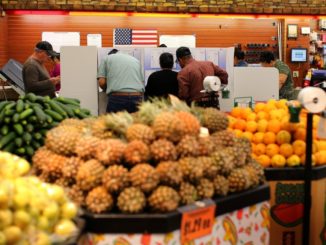
While 2018 was a year of economic revival with historically low unemployment and rising wage growth, demographic indicators stand in contrast, seemingly ushering in an era of population growth stagnation.
This was emphasized this week as the U.S. Census Bureau released its population change estimates for the year ending in July 2018. Their data show that the national rate of population growth is at its lowest since 1937, a result of declines in the number of births, gains in the number of deaths, and that the nation’s under age 18 population has declined since the 2010 census. This is on the heels of recently released data showing geographic mobility within the U.S. is at a historic low. And while some states—particularly in the Mountain West—are growing rapidly, nearly a fifth of all states displayed absolute population losses over the past two years.
While some of these downward demographic trends reflect the delayed impact of the Great Recession, the aging American population is the broader cause, a factor that the nation will have to cope with for years and decades to come.
A historic low for U.S. population growth
The U.S. population growth rate of 0.62 percent for 2017-2018 is the lowest registered in 80 years. While the nation’s growth rate varied through wars, economic upheavals, baby booms, and baby busts, the current rate reflects a further dip in a trend toward a lower level of growth—below 0.80 percent—registered since the Great Recession of 2007-2009.

More reliance on immigration as a contributor to growth
These downward growth trends initially reflected declines in immigration as well as lower natural increase (the excess of births over deaths) because the economy was down. But over the past few years, as immigration gained slight momentum, reduced natural increase was more responsible for the overall decline in population growth—as it dropped from 1.6 million in 2000-2001 to just above 1 million in 2017-2018. There were fewer births than in recent decades and more deaths than in earlier years (download Table A).

The decline in births may have been accentuated by young adult millennials, who, still bearing the brunt of the Great Recession, may be postponing births. However, the long-term trajectory should yield fewer rather than more births as the population ages, with proportionately fewer women in childbearing ages. The rise in deaths is more directly related to the nation’s aging population. Census Bureau projections show their rise to be the major cause of reductions in the nation’s natural increase over time.
This leaves immigration as an ever-more-important contributor to national population growth. In 2001-2002, natural increase exceeded immigration by 50 percent and that was when immigration was slightly higher than this year (1.05 million vs 0.99 million). Because of the recent decline in natural increase, immigration now contributes nearly as much to population growth, and is projected to be the primary contributor to national population growth after 2030 as natural increase continues to decline. Thus immigration—its size and its attributes—will be an important contributor to the nation’s future population that is growing slowly and aging quickly.
The child population is declining both nationally and in 29 states.
One consequence of fewer births in concert with an aging population is the slower growth of the nation’s younger population. The just-released census estimates show that between 2010 and 2018, the nation’s under-age 18 population declined by 780,000 (1 percent), while the adult population grew by 19.2 million (8 percent). The child population declined in 29 states: by more than 10 percent in the New England states of Vermont, New Hampshire, and Connecticut; and by more than 5 percent in 11 states located in parts of the Northeast, industrial Midwest, and in Mississippi, West Virginia and New Mexico (download Table B).
Those states which gained children include Texas, Utah, Florida, Washington, Idaho, and North and South Dakota. Most of these states recently gained migrants from other states or abroad, which added to their youth populations. Nonetheless, these data for the past eight years foreshadow another aspect of aging that census projections show: a long-term decline in the nation’s younger population share.
Geographical mobility hits a postwar low
If there is one demographic indicator that might be expected to pick up in a rebounding economy, it should be geographic mobility within the U.S. Yet the latest data for 2017-2018 released by the Census Bureau shows that the percentage of Americans changing residence is at a post-World War II low of 10.1 percent—continuing a slowdown observed last year (See Figure 3). This is less than half the rate the nation experienced in the highly mobile 1950s and substantially lower than in the 1990s.

The bulk of this downturn is attributable to local (within-county) moves, which also registered a postwar low, and could possibly be related to the “stuck in place” millennials, or specifically, the “older millennial” 25-34 year old age group, which particularly exhibits this mobility decline. But a new finding this year was the downward trend in inter-county and interstate migration—the types of moves that should accompany a rising labor market. Hence, the nation’s demographic stagnation appears with this indicator as well.
Nearly one-fifth of all states lost population in recent years
The national population growth slowdown did not occur in all parts of the country. Two states, Nevada and Idaho, grew by more than 2 percent between 2017 and 2018—continuing a recent boom in the Mountain West, which like other regions, took growth hits earlier in the decade. Among the 14 states which grew by more than 1 percent, all except South Dakota were located in the South and West (see Map 1).

Yet all is not upbeat even for the high flyers: Among those 14 states, 10 grew more slowly than in the previous year (download Table C). An interesting example is Texas, a state which weathered the earlier growth slowdown of the 2007-2009 recession relatively well. While Texas’s growth peaked this decade at a rate of 1.9 percent in 2014-2015, it dropped to 1.3 percent this year. Similarly, Florida, which took a hit during the recession, rebounded to grow by 2 percent in 2015-2016, only to fall to 1.5 percent growth this year.
The bigger story in the past two years is the number of states which lost population: 10 in 2016-2017 and nine this year, compared with only one or two earlier in the decade. These are states where current natural increase along with immigration could not counteract migration to other parts of the country. They include small-population states like Wyoming, Alaska, and Hawaii in the West; Louisiana, Mississippi, and West Virginia in the South; and large urban states such as New York and Illinois—the latter losing population for the fifth straight year. As natural increase dwindles, all states will rely more heavily on in-migration from the rest of the U.S. and abroad to fuel growth or stave off declines.
An aging, slow-growing future
This week’s release of census estimates appears to put an exclamation point on what we should be preparing for as the country ages and grows less rapidly from natural increase. The latest national growth rate of 0.62 percent is noticeably below what we have experienced in decades prior. While it is still far higher than in countries like Germany, Italy, and Japan, it means that policymakers must place increased attention on caring for a larger and more dependent aging population, and dealing with the realities of a slower-growing labor force. In particular, it requires a more serious discussion of U.S. immigration policy because of the future contributions that immigrants will make to growing America’s society and economy.
William H. Frey is Senior Fellow at Metropolitan Policy Program Brookings Institution



